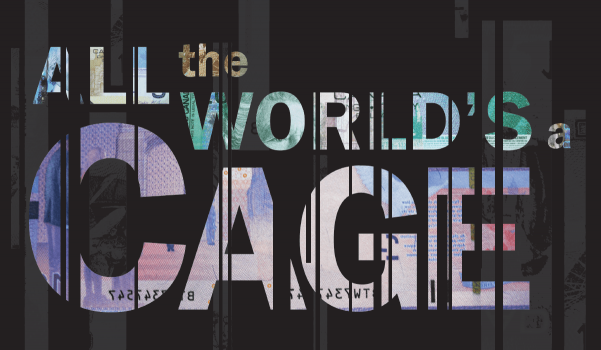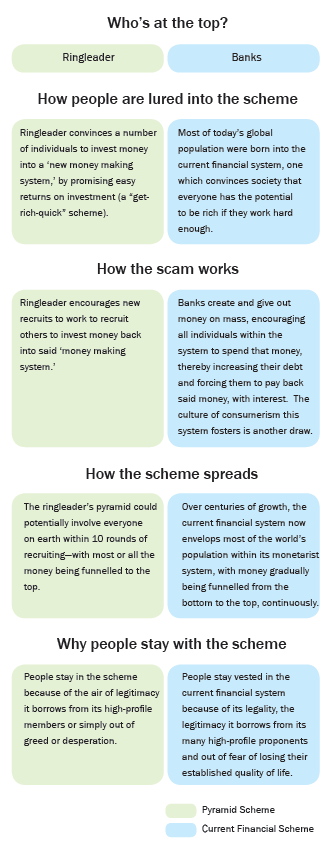Is the Financial System One Giant Pyramid Scheme?
A CAGE UNMASKED
On one hand we have a structurally flawed financial system and on the other, we have a pyramid scheme. How do the two relate?
To start, we must ask, “Who’s at the top of this pyramid?”
The simple answer is: those who control the world’s banks (especially the privately owned central banks, like the US Fed) and thus have the power to print money. Now, before this writer enters the realm of conspiracy theory, let me add an extra dimension to this answer: that unlike your average pyramid scheme, there’s actually no one person or group at the top.
People come and go, just as fortunes come and go. Instead, what you’ll see at the pyramid’s precipice is a system, one that promotes profit maximization above all other values. This single-minded drive is what the majority of global society has bought into and what the majority refuses to give up.
Why?
Because we all want to be at the top of that pyramid.
That’s the genius of this system. There is no one individual to point our fingers at because, at the end of the day, we’d only be pointing fingers at ourselves.
Until we, as a collective society, choose not to live under a system where power through the accumulation of money is the core value—a system where greed and corruption aren’t built in—we will forever be beholden to a system where only a small minority at the top prosper and the mass at the bottom struggle or go without.
But some may counter, “Okay, there might be people who let themselves be leashed by greed, but what about the rest of us? How can one system, or pyramid scheme, actually control the majority of the planet’s population?
[pullquote]“One thing to realize about our fractional reserve banking system is that, like a child’s game of musical chairs, as long as the music is playing, there are no losers.”
Andrew Gause, Monetary Historian[/pullquote]
The answer lies in how money is created and the existence of interest (both previously discussed). Essentially, this pyramid scheme creates money through banks that it gives out on mass, encouraging all individuals within the monetarist system to spend that money, thereby increasing their debt and forcing them to pay back said money, with interest or through various forms of bankruptcy.
For the minority of the world’s population who can pay these debts and remain debt free, this arrangement is of no consequence. But for the gross majority, those who can’t pay off 100% their debts by the month’s end or are living paycheque to paycheque, this system ensures a subtle form of veiled servitude—what some might call slavery.
If you don’t work, you won’t be able to pay your debts. If you can’t pay your debts, you won’t be able to keep your possessions and the standard of living to which you’ve grown accustomed. This fear of losing everything is what keeps the world in toe and what ensures the wealth of the bottom continues to flow upward to the banks and those who control them.
So let’s recap:
At this point, a final question begs answering: “If the financial system is just another fancy pyramid scheme, then why hasn’t it failed like all other pyramid schemes?”
The simple reason is that, for centuries, this scheme worked.
Yes, the system is far from balanced and the gap between rich and poor is large and growing everyday, but for all its flaws, the monetarist system of playing to people’s self-interest (greed and the pursuit of power) has resulted in a world far richer and better off today than in any time in human history.
THE RED PILL
But here’s the catch. While it’s true our monetarist system has provided humanity unprecedented wealth, it is also true that it was bankrolled almost entirely by our largest and oldest benefactor: the Earth.
To be clear, in order for the economy to continue growing, in order for it to avoid collapsing under the money supply’s constant expansion, more and more economic resources need to be mined from the earth, processed by man and commercialized by our markets.
Doing this produces enough new wealth fast enough to pay down all those new, interest-laden loans the banks are generally all too happy to give. It’s also what has allowed the human population to grow as much as it has, providing ever-growing numbers of new consumers for the system to exploit and grow.
In all, the flow of resources ensures the music continues to play.
So there you have it:
Debt + Interest + Inflation + ever increasing amounts of raw material and a growing population = the Superstructure of the Invisible Pyramid Scheme every member of society lives under.
It’s no different than what happens to a caribou herd when they discover a new land, one rich in food: they feed, multiply and prosper.
So too with humans.
When we learned the art of agriculture, it allowed us to produce an excess of food from the Earth’s soil and in turn, allowed us to shed off our nomadic lifestyle and commit to and develop communal living (i.e. families, villages, townships, cities, countries). Millennia later, humanity discovered how to harness energy from coal, leading to the first Industrial Revolution. A century later, humanity learned how to harness energy from oil and so the modern age began.
With each new discovery of how to use the Earth’s abundant resources, humanity fed, multiplied and prospered to new heights.
In fact, from the discovery of agriculture (approx. 8000 BC) to the Industrial Revolution (approx. 1800s), global human population gradually grew to around 800 million. Then within only 100 years after the Industrial Revolution, the population grew to one billion. Then after learning to truly harness oil, the most abundant and versatile energy source humanity ever discovered, global population exploded to roughly 6.3 billion and counting.
[pullquote]“Anyone who believes exponential growth can go on forever in a finite world is either a madman or an economist.”
Kenneth Boulding, Economist & founder of the Evolutionary Economics Movement[/pullquote]
Sad thing is, when the caribou herd grows to a point where they exhaust their land’s richness, the prosperity ends. Swaths of caribou starve and the herd shrinks back down to a level the land (Earth) can support. The herd may try and search for a new, richer land, but in the end, the cycle always repeat itself.
And again, so too with humans.
Soon, a time will come when events transpire to alter the very nature of modern society and “the system” as we know it. For pyramid schemes only continue expanding so long as there are more recruits and more money (resources) to pull into its sphere of influence. In other words, such scams can only continue existing in a world of infinite growth.
Sadly, that’s not the world we live in.
While modern economics and society in general choose to assume otherwise, the reality is that we live inside a finite world, a world with limits, both on the number of human beings it can support and the amount of resources it has available for consumption.
Eventually, something’s gotta give. And that something’s going to give within our lifetimes.
































Share the post "Is the Financial System One Giant Pyramid Scheme?"